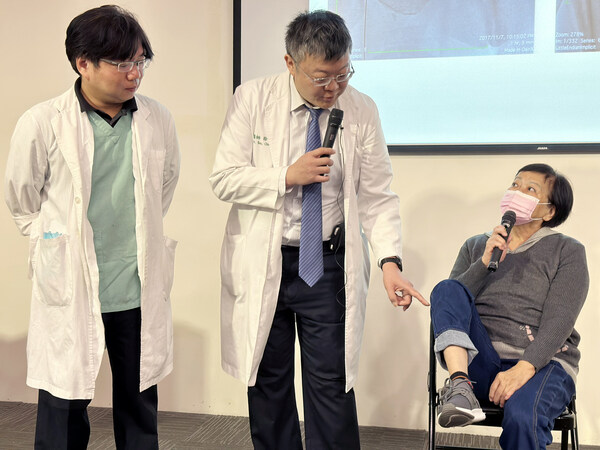|
TAICHUNG, In winter, cardiovascular diseases are more prevalent, which significantly increase the likelihood of arterial blockage. In addition to increasing the possibility of accompanying myocardial infarction or stroke, seniors should be especially cautious about Peripheral Arterial Occlusive Disease (PAOD). In mild cases, impaired walking, numbness and weakness during running are experienced; in cases of severe blockage, patients are at risk of developing gangrene (a dry, black sore) and frequently have their foot amputated eventually. If the event comes quickly - so called acute PAOD, even after receiving standard treatment, the mortality and amputation rates remain in the 20-30% range.

Chang, a 72-year-old female, (first from the right) has a history of hypertension, coronary artery occlusion, hyperthyroidism, and paroxysmal atrial fibrillation, as well as right lower extremity coldness with unusual pain. Dr. Hsu Chung-Ho (middle) examined thrombi in the popliteal artery of her right lower extremity, resulting in severe obstruction of blood flow in the lower extremity.
Since 2016, China Medical University Hospital (CMUH) in Taiwan has established the "24-hour thrombolysis team" to conduct research and treatment in response to this deadly disease. For acute PAOD patients, after emergent survey at Emergency Room (ER), Pharmacomechanical Thrombectomy (PMT) with Rotarex based atherectomy with or without Ekosonic Endovascular System (EKOS) are performed to treat patients with acute and severe arterial blockage in the lower extremities if indicated. The clinical amputation and mortality rates in regard of acute PAOD significantly reduced from 20-30% to 3%. The clinical results were published in the medical journal "International Angiology." "To prevent permanent necrosis of the muscle tissues and to lower mortality, a 24-hour standby medical team must be available to perform emergent thrombi removal within 'golden' hours before irreversible events develop." says Dr. Chung-Ho Hsu, director of the section of peripheral vascular disease, division of cardiovascular medicine, department of internal medicine, CMUH, Taiwan.
Miss Chang, a 72-year-old female, has a history of hypertension, coronary artery occlusion, hyperthyroidism, and paroxysmal atrial fibrillation. In spite of this, Chang experienced right lower extremity coldness with unusual pain suddenly. Following an ultrasound examination by Dr. Hsu, thrombi were discovered in the right popliteal artery, resulting in severe obstruction of blood flow in the lower extremity. CMUH convened the "24-hour thrombolysis team", where an emergent catheter-based thrombectomy/thrombolysis operation was performed under local anesthesia immediately. After PMT with Rotarex and thrombolysis with EKOS, Chang's blood circulation was greatly improved, and the amputation crisis was successfully averted.
Mr. Kou is another case of successful lower limb salvage treatment. Mr. Kuo is an 80-year-old patient with multiple chronic conditions: hypertension, diabetes, coronary artery occlusion, persistent atrial fibrillation, and heart failure, as well as chronic obstructive pulmonary disease. Mr.Kuo rushed to the ER in CMUH after experiencing right lower extremity coldness and sharp pain. Dr. Hsu discovered thrombi in the anterior tibial artery of Mr.Kuo's right lower extremity during an examination, resulting in poor blood circulation in the lower extremities. The thrombi were successfully removed after an emergent catheter-based thrombolysis with EKOS, as well as the use of drug-coated balloons and stents, and blood flow returned to normal, avoiding the fate of an amputation that could have resulted in severe disability.
Acute PAOD is frequently the result of atrial fibrillation, which causes thrombi to fall from the heart to the arteries of the lower extremities, resulting in a sudden and severe blockage. According to Director Hsu at CMUH, acute PAOD is most prevalent in the lower extremities, and symptoms include decreased temperature of the affected limb (frequently feeling cold), pain, pallor, numbness, poor walking ability, pulselessness, and paralysis. In the most severe cases of acute PAOD, muscle tissues develop ischemic necrosis, and patients are even forced to have limbs amputated or lost their life. Mortality will be as high as 100 percent if left untreated. Importantly, after amputation, these patients are likely to face life-threatening risks again, and condition will deteriorate due to less exercise after amputation, making this disease difficult to treat.
As for how to determine if one has PAOD, Dr. Hsu explains that the disease can be divided into four stages based on its severity and clinical manifestations (Fontaine stage):
Stage 1 (asymptomatic): No symptoms, only diseased lower limb arteries identified.
Stage 2: The legs are prone to fatigue and weakness during walking, but the patient can continue to walk after a short rest. The recurrence of the initial symptoms appears later on, which is given the name intermittent claudication.
Stage 3: Severe vascular obstruction and inadequate local circulation while at rest, which results in chronic pain,so called ischemic rest pain.
Stage 4: Ulcers and necrosis begin in the toes and spread to the feet and ankles as the skin changes color from pink to dark purple as a result of ischemia.
However, if the symptoms worsen quickly with either pain, pallor, poikilothermia, paresthesia, pulselessness, or paralysis, one should think about acute PAOD, which is a medical emergency and need to rush to the ER immediately.
For acute PAOD, CMUH will arrange vascular ultrasound immediately at ER and decide which is the clinical stage. If the condition is feasible, 24-hour thrombolysis team will be initiated to perform endovascular therapy immediately to save legs, also save lives. Acute PAOD often stems from atrial fibrillation, a condition that leads to the formation of thrombi in the heart which can then dislodge and block the arteries in the lower extremities, causing sudden and severe blockage. In light of this, Director Hsu strongly advises patients with atrial fibrillation to adhere to a regular regimen of anticoagulants to prevent thrombotic events. CMUH successfully reduced clinical amputation rates from 30% to 3%, and death rates from 30% to 3%. The clinical results were published in the medical journal "International Angiology" in April of 2022. Under the care of the "24-hour thrombolysis team" led by Director Hsu, their health and mobility have been restored. |